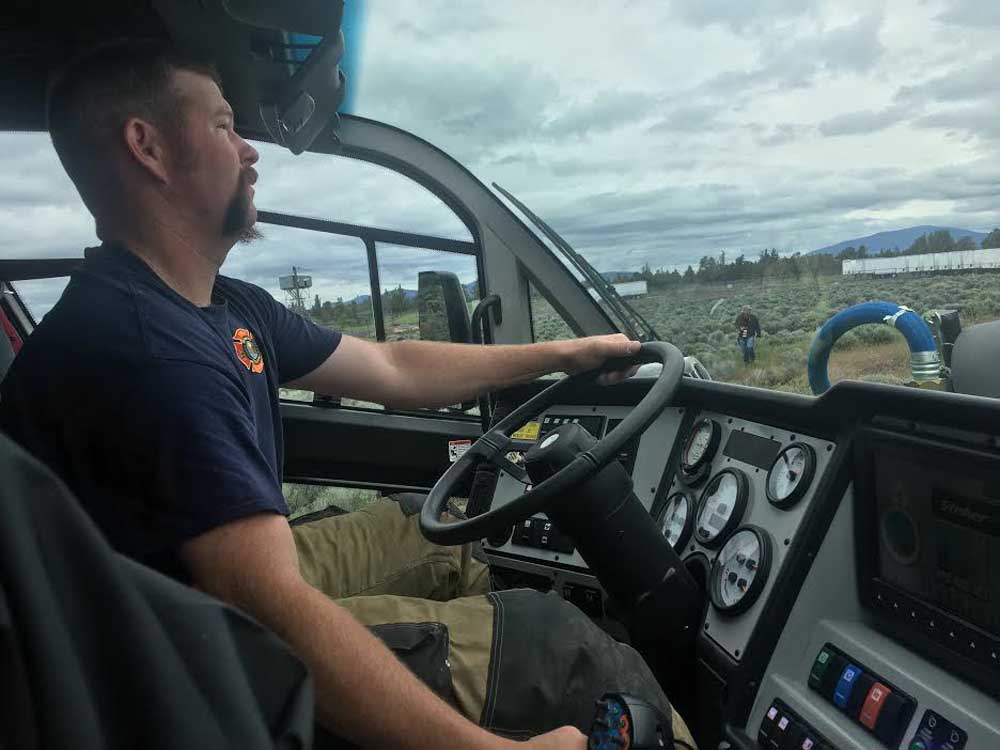Fiery training helps Redmond Airport prepare for tragedy
Published 12:00 am Friday, June 7, 2019

- Gary Abrams, a Redmond firefighter, drives the aircraft crash tender at Redmond Airport. (Garrett Andrews/The Bulletin)
Aircraft fires are exceedingly rare, but they are inevitable, according to fire officials. That’s why training is a way of life for firefighters like Gary Abrams, who’s certified to staff the one-person station at Redmond Airport.
Training is the reason he can roll up to a burning plane in a 35,000-pound, six-wheeled specialized fire engine and, before coming to a stop, flow water in a wide arc — while holding up his end of a conversation at the same time.
Trending
“Typically, what we do with an attack is we take either the nose or tail, depending on the wind, the geography and the fuel load,” Abrams said.
Redmond Fire Deputy Chief Jeff Puller watched Abrams shoot a powerful stream at a mock aircraft fuselage during a “live burn” training exercise Thursday outside the U.S. Forest Service operations center at the airport.
“That’s textbook right there,” Puller said. “He’s actually using all that water that’s coming off of the side, that mist, to put that fire out. He doesn’t actually have to hit it directly.”
Redmond’s aircraft crash tender holds 3,000 gallons of water, or three times more than a standard structural fire engine, and it can shoot 1,500 gallons of water a minute.
It’s called “water,” but the liquid coming from the engine’s two turrets is a mixture of water, foam and dry-chem, something like the chemical found in a handheld fire extinguisher.
The critical difference between a structure fire and an aircraft fire is jet fuel, which is highly flammable, and burns hot and fast.
Trending
So aircraft tenders are specifically designed to get water out immediately.
“Airport firefighting is a unique specialty,” Redmond Chief Doug Perry said. “It’s unique because of the fuel load. It’s a heavy fuel load. It’s very explosive. Very powerful.”
Redmond Airport is rated an Index B airport by the Federal Aviation Administration, meaning one firefighter must be on duty at all times in order for commercial flights to take off and land.
On the other end of the spectrum, Portland International Airport is an Index E airport, meaning there are numerous firefighters staffing multiple engines across two stations.
Because Redmond Airport is rated to be staffed by one firefighter, its crash tender is designed to be operated by one person.
And per the FAA, that firefighter has one minute and 30 seconds to get to any aircraft fire.
Redmond fire department’s main station in downtown Redmond is nearly 3 miles from the airport runways, which means that a firefighter has seven to 10 minutes alone with a burning aircraft before backup arrives.
Though major, mass-casualty disasters are rare, emergencies at airports are more common than people might think. In the past month and a half, the airport’s crash rig has responded to seven aircraft emergencies.
Most of those incidents were minor. For instance, a pilot radioed ahead to say an emergency light was flashing in the cockpit and wanted firefighters on scene standing by.
On April 10, the pilot of a United flight carrying 30 passengers pulled the emergency brake and popped four rear tires on the Bombardier CRJ-200.
Live-fire aircraft training like the one Thursday is just one component of what the FAA requires. There are 10 other chapters in its training book, including mass casualties and extrication, and firefighters train for this continually.
Airport firefighters are required to have one “live burn” a year to remain airport-certified. In past years, local agencies have flown personnel outside the area to attend trainings. This year is the first time the airport brought in an outside consultant to assist with training. Brookfield, Ohio-based 139Fire has three Mobile Air Fire Trainers it ships around the country.
The one used Thursday was built in 2012 and has been torched thousands of times at airfields around the West Coast.
Airport firefighting takes a higher level of skill, and there’s no associated bump in pay. But people still put in for the work, according to officials.
“Ninety-nine percent of the time, you’re doing nothing,” Abrams said. “But 1% of the time, you’re doing 99% of the work.”
— Reporter: 541-383-0325, gandrews@bendbulletin.com








